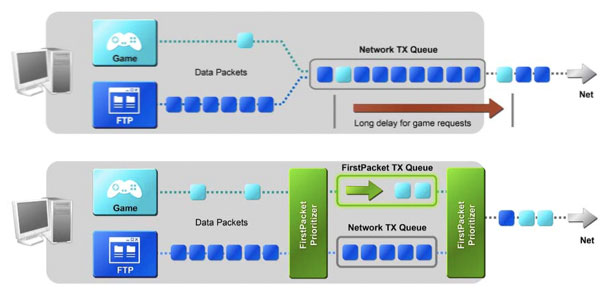DualNet
Many motherboards now come with dual gigabit LAN. With nForce 500-series, NVIDIA is integrating dual gigabit into the chipset and providing a number of ways of configuring those ports.Sure, you can have two standard interfaces if you want. But with DualNet, you can combine both those ports in software to act as a single, two-gigabit connection. Theoretically, this will enable you to serve files and game data to client machines far faster than you otherwise could. The router you are connected to, whilst having two cables plugged in, sees the host as just a single socket - as does Windows. All of the configuration is done by the driver.

The networking driver also has fail-over, reverting back to just 1Gb seamlessly should one cable be unplugged.
We tested a similar technology, known as Teaming, on DFI's LANParty CFX3200-DR, and found that there was no tangible benefit to using it, aside from the seamless fail-safe fall back to a single port if one should fail. It will be interesting to see whether NVIDIA's implementation provides any tangible performance benefits.
FirstPacket
With enthusiasts doing more and more things simultaneously thanks to outrageous memory configurations and dual-core chips, FirstPacket provides a prioritisation protocol for your net connection.Obviously, if you're gaming online, you would turn off things like BitTorrent as they would kill your upstream bandwidth. With FirstPacket, you can configure the NVIDIA driver to prioritise data packets from your game over data packets from your Torrent client, cutting the lag you would otherwise experience severely.

Network traffic without FirstPacket (above) and with (below).
Another example is that you could use VoIP communications in a game but prioritise traffic from the game itself to make sure that your comms don't affect your performance. Whilst FirstPacket can't enlarge your bandwidth, it can cut down on the latency that packets face.
To configure, you can simply go into the driver and tell it what programme you'd like prioritised in terms of packets. You can set up lists, so Programme A can be higher than Programme B but lower than Programme C. Obviously, this could get quite complex, but we like the fact that it is possible to prioritise some traffic above others. FirstPacket only works on upstream, not downstream traffic.

MSI MPG Velox 100R Chassis Review
October 14 2021 | 15:04






Want to comment? Please log in.